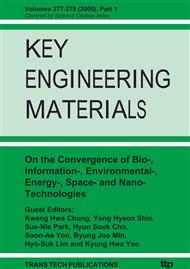p.130
p.137
p.142
p.148
p.155
p.162
p.171
p.177
p.183
Production of Novel Exopolysaccharide with Emulsifying Ability from Marine Microorganism, Alteromonas sp. Strain 00SS11568
Abstract:
To find a novel exopolysaccharide, marine bacterial strains were isolated from coastal regions of Korea. Strain 00SS11568 was then selected as it produced a mucous exopolysaccharide during the stationary phase in a batch culture. The isolate was identified as Alteromonas sp. based on its 16S rDNA sequence, morphological, and biochemical properties. The exopolysaccharide, designated as p-11568, exhibited an emulsifying ability. The Emulsification Index (E24) of 0.1% p- 11568 was 77.4% with an emulsified kerosene content, and was higher than those of commercial polysaccharides, such as xanthan gum (26.1%), gellan gum (1.3%), and sodium alginate (2.0%). p- 11568 was found to be composed of glucose and galactose as the main natural sugars in a molar ratio of 1.3:1, along with uronic acid (18.9%, w/w) and sulfate groups (1.2% w/w). The average molecular mass was 4.4 x 105 daltons by gel filtration chromatography. The effects of pH, temperature, inorganic compounds, and C and N sources were tested to obtain the optimal medium composition for the production of p-11568. Under optimal growth conditions with the M-11568 medium, 14.9 g of crude p-11568 per liter was obtained.
Info:
Periodical:
Pages:
155-161
Citation:
Online since:
January 2005
Authors:
Keywords:
Price:
Сopyright:
© 2005 Trans Tech Publications Ltd. All Rights Reserved
Share:
Citation:


